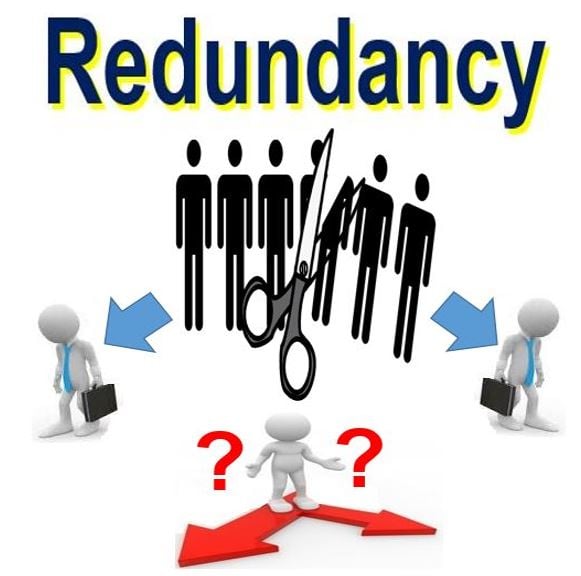Exploring the Interplay Between Company Redundancy and Organizational Flexibility for Future Growth
In the dynamic landscape of today's organization globe, the complex relationship in between firm redundancy and organizational flexibility arises as an essential variable for sustained development and success. Firms commonly encounter the obstacle of striking a delicate balance in between maintaining a level of redundancy to alleviate dangers and fostering versatility to respond quickly to the ever-evolving market demands.
Significance of Company Redundancy
Business redundancy is a vital aspect that enhances business resilience and reduces operational dangers. By incorporating redundancy measures within the organizational framework, companies can much better withstand unforeseen disturbances and changes in the organization environment. Redundancy functions as a strategic barrier, allowing business to adapt and respond efficiently to unexpected challenges without jeopardizing crucial procedures.
One key aspect of the value of firm redundancy is its role in guaranteeing connection during times of dilemma. When confronted with abrupt modifications or emergencies, redundant systems, resources, or workers can step in to maintain critical features and prevent prevalent interruptions. This connection not only safeguards the company's credibility and customer trust yet also decreases economic losses and operational downtime.

Methods for Organizational Flexibility

An additional crucial approach is purchasing innovation and infrastructure that can sustain versatility and scalability. Executing electronic devices, automation, and data analytics can streamline procedures, enhance efficiency, and give valuable understandings for educated decision-making. Additionally, developing adaptable organizational structures that permit for quick changes to market characteristics and customer requirements is important for remaining affordable in a quickly advancing setting. By proactively identifying potential disturbances and chances, companies can proactively grow and adjust in an ever-changing organization landscape.
Balancing Redundancy and Versatility
Accomplishing an unified balance between functional redundancy and organizational flexibility is extremely important in navigating the complexities of a vibrant company setting. Redundancy within a firm supplies a safety and security net, ensuring connection and stability in operations. Nevertheless, an excess of redundancy can bring about inefficiencies and prevent versatility to transforming market problems. On the various other hand, business flexibility allows companies to react immediately to external disruptions and take brand-new chances. Striking the best equilibrium in between redundancy and flexibility is a delicate procedure that calls for a deep understanding of the company's objectives, sector characteristics, and risk resistance.
To attain this balance, companies require to conduct regular evaluations of their procedures to identify locations where redundancy is needed for risk reduction and where versatility can drive innovation and growth. Carrying out adaptable structures, promoting a culture of go to these guys continuous learning and enhancement, and urging open interaction across all levels of the organization are crucial methods to balance redundancy and adaptability efficiently. By aligning these two crucial aspects, business can place themselves for sustainable development and success in an ever-changing service landscape.
Instance Studies on Adaptation Success
In taking a look at circumstances of effective business adjustment, it becomes evident that the interplay between functional redundancy and versatility is a defining aspect in shaping durable companies. A DVD rental service, Netflix showed amazing versatility by transitioning right into a streaming system when digitalization disrupted the market. These instance studies emphasize the significance of functional redundancy paired with this content business flexibility in promoting long-lasting development and competition.
Building Strength for Future Development
Building resilience for future development needs a strategic positioning of operational procedures with market characteristics and arising fads. Business should adapt to changing atmospheres by cultivating a culture of flexibility, innovation, and continual improvement.
In addition, cultivating solid connections with stakeholders, such as clients, staff members, suppliers, and the community, is important for preserving and weathering uncertainties trust and assistance throughout rough times. Reliable communication and transparency play a vital role in building resilience, as they assist straighten expectations and promote cooperation in navigating unpredictabilities.
Furthermore, organizations need to focus on learning and development efforts to upskill workers and outfit them with the required tools to adjust to altering scenarios. By buying their labor force, firms can enhance their flexibility and agility, eventually reinforcing their strength for sustainable future development.
Final Thought

In the vibrant landscape of today's organization world, view it now the elaborate relationship in between firm redundancy and business adaptability emerges as a vital factor for continual growth and success. Companies often face the obstacle of striking a delicate balance between preserving a degree of redundancy to minimize threats and promoting flexibility to react swiftly to the ever-evolving market demands.To attain this balance, companies need to conduct regular analyses of their procedures to determine locations where redundancy is required for risk mitigation and where versatility can drive development and growth.In conclusion, the interplay between business redundancy and business versatility is essential for future development. Building strength through a combination of redundancy and flexibility will certainly ensure that business are prepared for the obstacles of the future.
Comments on “If a Company Goes Bust Who Pays Redundancy? Legal Insights for UK Employees”